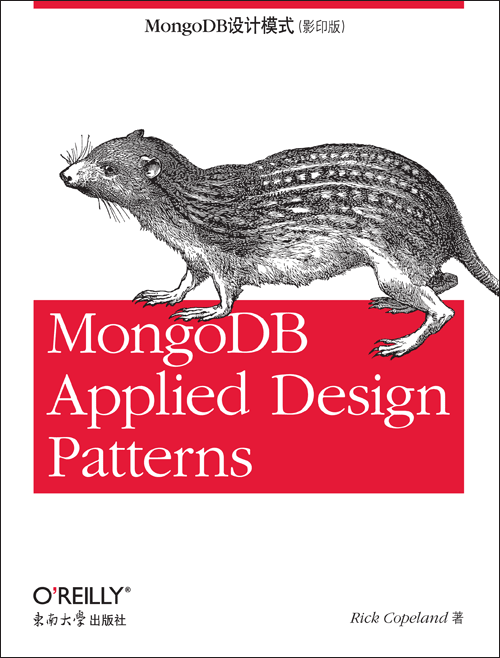MongoDB设计模式(影印版)
出版时间:2013年10月
页数:160
“对于新手和那些想要获取更多实践知识的有经验用户来说,《MongoDB设计模式》都是一本必要的读物。”
——Michael Dirolf
《MongoDB:The Definitive Guide》作者之一
无论你正在搭建一个社交媒体网站还是一个内部使用的企业应用,这本注重实践的指南都可以为你展示出在MongoDB和它所用来解决的商业问题之间的紧密联系。你将学习如何把MongoDB设计模式应用到多个具有挑战性的领域中,比如电子商务、内容管理和在线游戏。通过使用Python和JavaScript的代码实例,你将了解MongoDB是如何让你在调整数据模型的同时简化开发流程。
很多商业应用在还没有理解如何更有效地使用NoSQL数据库之前就直接启用了它。这本书将为你演示文档嵌入、多态性架构和其他处理特定大数据用例的MongoDB模式的优势所在,包括:
· 营运智能:执行商业数据的实时分析
· 电子商务:让MongoDB成为产品目录大师或者库存管理系统
· 内容管理:学习用来存储内容节点、二元资产和讨论区的方法
· 在线广告网络:把技术运用于广告播放的频次控制、关键字定位和竞价
· 社交网络:学习如何存储一个仿效Google+的复杂社交图
· 在线游戏:为一个多人角色扮演游戏提供对人物和世界数据的并发访问
Rick Copeland是Arborian咨询公司的首席咨询师和创办者。Arborian咨询公司是一家着重于MongoDB和Python定制开发和培训的商业机构。作为《Essential SQLAlchemy》(O’Reilly)的作者,Rick是10gen公司的“MongoDB大师”的创立委员之一。
——Michael Dirolf
《MongoDB:The Definitive Guide》作者之一
无论你正在搭建一个社交媒体网站还是一个内部使用的企业应用,这本注重实践的指南都可以为你展示出在MongoDB和它所用来解决的商业问题之间的紧密联系。你将学习如何把MongoDB设计模式应用到多个具有挑战性的领域中,比如电子商务、内容管理和在线游戏。通过使用Python和JavaScript的代码实例,你将了解MongoDB是如何让你在调整数据模型的同时简化开发流程。
很多商业应用在还没有理解如何更有效地使用NoSQL数据库之前就直接启用了它。这本书将为你演示文档嵌入、多态性架构和其他处理特定大数据用例的MongoDB模式的优势所在,包括:
· 营运智能:执行商业数据的实时分析
· 电子商务:让MongoDB成为产品目录大师或者库存管理系统
· 内容管理:学习用来存储内容节点、二元资产和讨论区的方法
· 在线广告网络:把技术运用于广告播放的频次控制、关键字定位和竞价
· 社交网络:学习如何存储一个仿效Google+的复杂社交图
· 在线游戏:为一个多人角色扮演游戏提供对人物和世界数据的并发访问
Rick Copeland是Arborian咨询公司的首席咨询师和创办者。Arborian咨询公司是一家着重于MongoDB和Python定制开发和培训的商业机构。作为《Essential SQLAlchemy》(O’Reilly)的作者,Rick是10gen公司的“MongoDB大师”的创立委员之一。
- Chapter 1: To Embed or Reference
- Relational Data Modeling and Normalization
- MongoDB: Who Needs Normalization, Anyway?
- Conclusion
- Chapter 2: Polymorphic Schemas
- Polymorphic Schemas to Support Object-Oriented Programming
- Polymorphic Schemas Enable Schema Evolution
- Polymorphic Schemas Support Semi-Structured Domain Data
- Conclusion
- Chapter 3: Mimicking Transactional Behavior
- The Relational Approach to Consistency
- Compound Documents
- Using Complex Updates
- Optimistic Update with Compensation
- Conclusion
- Use Cases
- Chapter 4: Operational Intelligence
- Storing Log Data
- Pre-Aggregated Reports
- Hierarchical Aggregation
- Chapter 5: Ecommerce
- Product Catalog
- Category Hierarchy
- Inventory Management
- Chapter 6: Content Management Systems
- Metadata and Asset Management
- Storing Comments
- Chapter 7: Online Advertising Networks
- Solution Overview
- Design 1: Basic Ad Serving
- Design 2: Adding Frequency Capping
- Design 3: Keyword Targeting
- Chapter 8: Social Networking
- Solution Overview
- Schema Design
- Operations
- Sharding
- Chapter 9: Online Gaming
- Solution Overview
- Schema Design
- Operations
- Sharding
- Afterword
- Where Do I Go from Here?
- Index
书名:MongoDB设计模式(影印版)
作者:Rick Copeland 著
国内出版社:东南大学出版社
出版时间:2013年10月
页数:160
书号:978-7-5641-4458-6
原版书书名:MongoDB Applied Design Patterns
原版书出版商:O'Reilly Media
The animal on the cover of MongoDB Applied Design Patterns is the thirteen-lined ground squirrel (Ictidomys tridecemlineatus), also known as the leopard ground squirrel, squinney, or striped gopher. It gains both its Latin name (tredecim meaning thirteen) and common name from the 13 alternating dark and light lines that run down its back and sides. It also has spots within the darker stripes of fur, which help camouflage the animal in its grassland habitat.
Thirteen-lined ground squirrels are widespread in the Great Plains region of North America, and in fact are the reason for Minnesota’s nickname “The Gopher State” (though this is a misnomer, as they are not members of the gopher family). Strictly active during the day, this squirrel’s diet consists of grass, seeds, and insects. They prefer open areas with short grass and well-drained soil for creating their burrows. Though they live individually rather than in colonies, there may be as many as 20 ground squirrels per acre in a particularly good habitat.
These animals range from 6–11 inches long, and their weight varies widely depending on the time of year. Most usually weigh between 5–6 ounces, but can get near half a pound when preparing for winter hibernation. In preparation, the ground squirrel puts on a heavy layer of fat and stores food in its burrow. Around October, it enters the burrow, rolls into a tight ball, and decreases its respiration to about one breath every five minutes, until it emerges again in March or April.
Each thirteen-lined ground squirrel’s burrow is around 15–20 feet long, with several side passages and multiple entrances. With the exception of the hibernation chamber, the burrows are no more than 1-2 feet below the surface. Typically, the tunnel turns sharply near its beginning, to trick digging predators into believing that the burrow has dead-ended.
Thirteen-lined ground squirrels are widespread in the Great Plains region of North America, and in fact are the reason for Minnesota’s nickname “The Gopher State” (though this is a misnomer, as they are not members of the gopher family). Strictly active during the day, this squirrel’s diet consists of grass, seeds, and insects. They prefer open areas with short grass and well-drained soil for creating their burrows. Though they live individually rather than in colonies, there may be as many as 20 ground squirrels per acre in a particularly good habitat.
These animals range from 6–11 inches long, and their weight varies widely depending on the time of year. Most usually weigh between 5–6 ounces, but can get near half a pound when preparing for winter hibernation. In preparation, the ground squirrel puts on a heavy layer of fat and stores food in its burrow. Around October, it enters the burrow, rolls into a tight ball, and decreases its respiration to about one breath every five minutes, until it emerges again in March or April.
Each thirteen-lined ground squirrel’s burrow is around 15–20 feet long, with several side passages and multiple entrances. With the exception of the hibernation chamber, the burrows are no more than 1-2 feet below the surface. Typically, the tunnel turns sharply near its beginning, to trick digging predators into believing that the burrow has dead-ended.
购买选项
